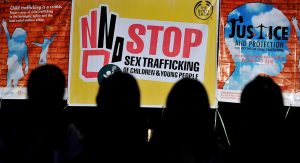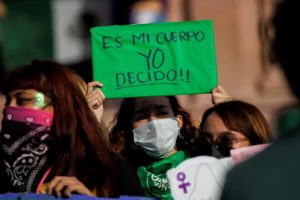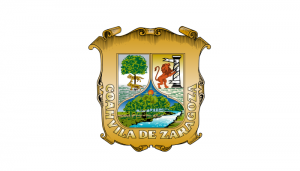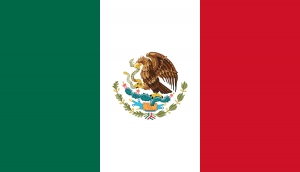By Victoria Sluder
Sold, captured, and scammed. These are the methods by which men, women, and children are trafficked every year. In recent years, women and children are the primary targets for trafficking of all kinds due to poverty, unstable political climates, and errors in the criminal  justice system. There are protocols put in place for obligatory purposes, but they are contradictory at best and have a lot of grey area. The United Nations Protocol on Human Trafficking defines trafficking as:
justice system. There are protocols put in place for obligatory purposes, but they are contradictory at best and have a lot of grey area. The United Nations Protocol on Human Trafficking defines trafficking as:
Trafficking in persons shall mean the recruitment, transportation, transfer, harbouring or receipt of persons, by means of the threat or use of force or other forms of coercion, of abduction, of fraud, of deception, of the abuse of power or of a position of vulnerability or of the giving or receiving of payments or benefits to achieve the consent of a person having control over another person, for the purpose of exploitation. Exploitation shall include, at a minimum, the exploitation of the prostitution of others or other forms of sexual exploitation, forced labour or services, slavery or practices similar to slavery, servitude or the removal of organs… The recruitment, transportation, transfer, harbouring or receipt of a child for the purpose of exploitation shall be considered “trafficking in persons.
While this protocol defines trafficking, it does not define how this crime should be punished and incorrectly defines other forms of sex work as trafficking. It does, however, discuss the services and opportunities available to victims as well as offer suggestions to states about how to follow the protocol. It should also be mentioned that even though this huge protocol was put in place in 2000, human trafficking is still an enormous problem around the world, with an estimated 20-40 million active victims. Traffickers average about $150 million dollars a year in profits of which $99 million comes from sexual exploitation. In 2018, the United States reported that 52 percent of their criminal human trafficking cases involved children specifically.
Because there is no universal method to prevent and crack down on trafficking, it is up to individual countries to determine how to best handle the issue. For example, many Southeast-European and Mediterranean areas do little to address the problem considering trafficking continues to occur in large numbers, mainly due to the high amount of traffic in the area which create a hotbed of trafficking prospects because of the transient population. In these countries, many previous victims have stated that traffickers arranged documentation for them to travel to the area and stay there. When many had to renew visas local governments did not ask any questions and so did nothing to stop the exploitation.
While many countries do have laws and protocols against human trafficking, enforcement is often lax because traffickers have the funds to bribe officials to look the other way. Law enforcement may even receive a different status because of their ties which allows leverage for trafficking and similar crimes to continue because they are not reporting the trafficking like they should be because of the benefits they receive from not doing so. This violates not only laws against human trafficking but also the oaths that many officers take to “protect and serve”, their enabling of the problem is a gross injustice to victims that need rescuing from their exploitation.
Aside from the corruption in law enforcement agencies of all levels, there are the issues that many find within the United Nations’ Protocol on Human Trafficking. The Protocol is a band-aid over the gaping wound that is human trafficking. It was an attempt to provide some assistance to victims as well as suggest that each state involved create some kind of legislation in response to trafficking crimes. The incentive for legislation in and of itself leaves a lot to the imagination because it does not establish how severe traffickers should be punished or even what class of crime trafficking is in different areas (I.e., felony or misdemeanor). The Protocol also is contradictory in how it addresses voluntary sex work, and that the migration of voluntary sex workers is not exploitative or coincides with trafficking.
The criminal justice system fails to provide justice to victims in many ways. For example, sometimes there is not enough evidence to convict someone of trafficking, there are people with deep pockets involved that can pay off DA’s or judges, and when a trafficker is convicted they may only serve a small amount of time compared to the amount victims and the public feel they should serve. An example of this is the case of a young woman who was trafficked in Kathmandu. She managed to escape and her family pressed charges against the men who sought to traffic her, amidst threats and intimidation, they won the case but only the men who were of lesser financial situations received jail time and a small amount at that. She felt the case was a bittersweet victory and ended her tail asking where she would truly find justice. There is also a heavy stigma attached to many trafficking victims around the world, these stigmas are also a method of confinement many traffickers use to hold their victims because it is a sad truth that if they did escape, they would face judgement for being involved in sex work of any kind- whether it was forced or not.
The need for reform in response to the global issue of human trafficking not only lies within the criminal justice system but also within governments around the world. There are many methods that states all over the world use to appear to be progressive while actually doing nothing to address the problem. Many states will exaggerate numbers of victims and hide the accurate statistics, like in the United States who reported over 50,000 women and children who had been trafficked in 2002 when there was actually between 15-18 thousand. Others will focus solely on women and ignore men and the increasing number of children who are also being exploited, and lastly, claiming that trafficking is a “human rights issue” while doing little to nothing to prosecute traffickers for violations of human rights (like in the case above where offenders were only prosecuted for a short time for a small offense). Ignoring the growing problem of trafficking in persons is a gross injustice to the millions (yes millions) of people who are trafficked every year and they deserve justness.
Many point the finger as to who is responsible for fighting the war that is human trafficking but at the end of the day it boils down to the criminal justice system, whose role is to protect and serve, and governments around the world. Human trafficking happens closer to home than a lot of people think, and it is also our responsibility as citizens to put the pressure on those in charge, reform needs to happen and clearly those who care need to kickstart the process so victims can feel the justice they have been deprived of for so long.
Victoria Sluder is a criminal justice major with a minor in leadership studies. She plans to attend East Carolina University for her Masters in psychology and remain active in the Student Government Association.








 justice system. There are protocols put in place for obligatory purposes, but they are contradictory at best and have a lot of grey area. The United Nations Protocol on Human Trafficking defines trafficking as:
justice system. There are protocols put in place for obligatory purposes, but they are contradictory at best and have a lot of grey area. The United Nations Protocol on Human Trafficking defines trafficking as:

